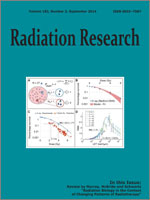Previous ground-based experiments have shown that cranial irradiation with mission relevant (20 cGy) doses of 1 GeV/nucleon 56Fe particles leads to a significant impairment in Attentional Set Shifting (ATSET) performance, a measure of executive function, in juvenile Wistar rats. However, the use of head only radiation exposure and the biological age of the rats used in that study may not be pertinent to determine the likelihood that ATSET will be impaired in Astronauts on deep space flights. In this study we have determined the impact that whole-body exposure to 10, 15 and 20 cGy of 1 GeV/nucleon 56Fe particles had on the ability (at three months post exposure) of socially mature (retired breeder) Wistar rats to conduct the attentional set-shifting paradigm. The current study has established that whole-body exposures to 15 and 20 (but not 10) cGy of 1 GeV/nucleon 56Fe particles results in the impairment of ATSET in both juvenile and socially mature rats. However, the exact nature of the impaired ATSET performance varied depending upon the age of the rats, whether whole-body versus cranial irradiation was used and the dose of 1 GeV/u 56Fe received. Exposure of juvenile rats to 20 cGy of 1 GeV/nucleon 56Fe particles led to a decreased ability to perform intra-dimensional shifting (IDS) irrespective of whether the rats received head only or whole-body exposures. Juvenile rats that received whole-body exposure also had a reduced ability to habituate to the assay and to complete intra-dimensional shifting reversal (IDR), whereas juvenile rats that received head only exposure had a reduced ability to complete compound discrimination reversal (CDR). Socially mature rats that received whole-body exposures to 10 cGy of 1 GeV/nucleon 56Fe particles exhibited no obvious decline in set-shifting performance; however those exposed to 15 and 20 cGy had a reduced ability to perform simple discrimination (SD) and compound discrimination (CD). Exposure to 20 cGy of 1 GeV/nucleon 56Fe particles also led to a decreased performance in IDR and to ∼25% of rats failing to habituate to the task. Most of these rats started to dig for the food reward but rapidly (within 15 s) gave up digging, suggesting that they had developed appropriate procedural memories about food retrieval, but had an inability to maintain attention on the task. Our preliminary data suggests that whole-body exposure to 20 cGy of 1 GeV/nucleon 56Fe particles reduced the cholinergic (but not the GABAergic) readily releasable pool (RRP) in nerve terminals of the basal forebrain from socially-mature rats. This perturbation of the cholinergic RRP could directly lead to the loss of CDR and IDR performance, and indirectly [through the metabolic changes in the medial prefrontal cortex (mPFC)] to the loss of SD and CD performance. These findings provide the first evidence that attentional set-shifting performance in socially mature rats is impaired after whole-body exposure to mission relevant doses (15 and 20 cGy) of 1 GeV/nucleon 56Fe particles, and importantly that a dose reduction down to 10 cGy prevents that impairment. The ability to conduct Discrimination tasks (SD and CD) and reversal learning (CDR) is reduced after exposure to 15 and 20 cGy of 1 GeV/nucleon 56Fe particles, but at 20 cGy there is an additional decrement, ∼ 25% of rats are unable to maintain attention to task. These behavioral decrements are associated with a reduction in the cholinergic RRP within basal forebrain, which has been shown to play a major role in regulating the activity of the PFC.
How to translate text using browser tools
16 July 2014
Exposure to Mission Relevant Doses of 1 GeV/Nucleon 56Fe Particles Leads to Impairment of Attentional Set-Shifting Performance in Socially Mature Rats
Richard A. Britten,
Leslie K. Davis,
Jessica S. Jewell,
Vania D. Miller,
Melissa M. Hadley,
Larry D. Sanford,
Mayumi Machida,
György Lonart
ACCESS THE FULL ARTICLE

Radiation Research
Vol. 182 • No. 3
September 2014
Vol. 182 • No. 3
September 2014




